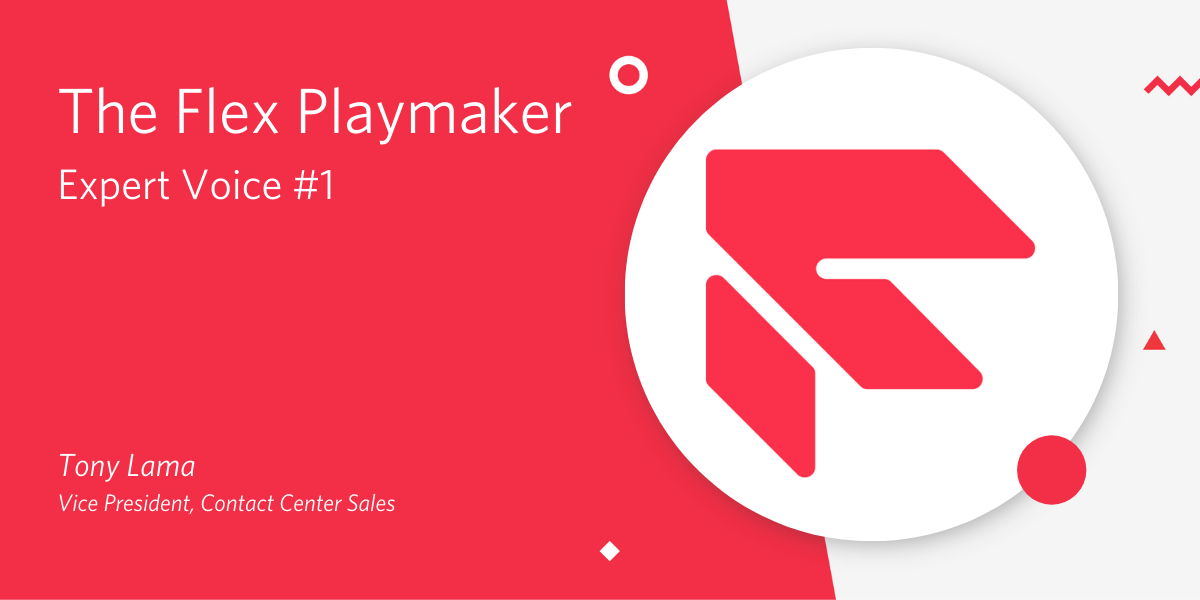The Flex Playmaker Expert Voice #1 – Tony Lama
Time to read: 5 minutes

Welcome to the first interview on ‘The Flex Playmaker’ series. When planning for these series of interviews with leaders championing Flex, I had only one person in mind to start the series - Tony Lama.
Tony Lama is a contact center technology veteran with over 22 years of experience and proven successes in the development and execution of global go to market strategies. Tony joined Twilio in 2019 to lead Twilio's Contact Center Sales and GTM.
Tony's unique set of experiences having trained, tested, deployed, supported, architected, evangelized, and sold contact center technology make him a unique Sales/GTM leader. Tony has helped successfully launch and support numerous contact center offerings at both Aspect and Amazon Web Services prior to joining Twilio.
Get to know Tony
Tony was born and raised in Hialeah, Florida, which was once the city with the most foreign born American citizens in the country. He is the son of Cuban immigrants that fled the Castro regime in the early sixties and his family’s experiences heavily influenced his love and passion for public service.
Here are some little known facts about Tony:
- He interned at the White House in 1996.
- He ran and was elected twice as Councilman and later as Vice-Mayor of the Town of Miami Lakes.
- Tony has a Black Belt in Tae Kwon Do and studied Aikido and Jujitsu for many years as an adult.
Tony and his wife Eileen are the parents of 4 wonderful kids (Mia 22, Sophia 19, Anthony 13 & Lucas 11).
An interview with Tony Lama
This interview was conducted on October 4th, 2020. Let’s get to know Tony Lama, the person leading the charge on disrupting the Contact Center space with Twilio Flex.
Say it’s Sunday night (or Monday AM), you’re looking at your calendar for the upcoming week - what is running through your mind?
How much more can I possibly fit into my day? I joined Twilio because I wanted to be a part of a team that would transform the way companies engage with and serve their customers. The companies I interacted with prior to Twilio were increasingly asking for a higher degree of programmability and control. No other vendor could offer that! They wanted to shift from being users and buyers of tech to being builders. However, not everyone has made this shift to being builders and I’m always trying to find ways to maximize my calendar and share this vision with Twilio customers.
We have significantly increased our headcount within the Flex Org. In the many interviews you have conducted, what were some of the general themes you were looking for from potential candidates?
This is a great question. When I interview candidates, I’m interested in hearing how the candidate establishes trust with peers, leaders, and customers. So much of our success as a company and as individuals rides on establishing trust and building relationships with others. When it comes to Twilio Flex, we are asking customers to reimagine the way they manage and operate their contact centers; We are asking them to shift from being users of tech to being builders. This could be scary for some customers. So, it’s critical that the people I interview not only have the skills and experiences, but that they can establish trust with customers and will be tireless advocates for their customers. Lastly, I’d say I like to look for people that insist on high standards and aren’t afraid to push the org to grow and be better.
Let’s move on to Flex the product.
The World's most flexible cloud contact center
What was the exact compelling reason that led Twilio to come out with Flex?
Like everything we do at Twilio, it starts with customers. We kinda stumbled upon contact centers when early in Twilio’s history, developers started to solve for contact center use cases with our APIs. Companies with builder DNA like ING were using Twilio APIs to take control of their customer care roadmap and toss out their legacy vendors. We realized that we had an opportunity to make elements of that transition...such as the agent UI, orchestration of channels, and reporting...easier for our customers. And that’s how Twilio Flex was born. We wanted to make it easy for our customers to move their contact center workloads to the cloud by solving for the most challenging aspects of that transition.
We have taken this contrarian view compared to all the other legacy vendors in this space, in the sense that… flex is fully programmable as opposed to a product that has a certain limited set of features. What has been the biggest learning curve in this journey?
We are on a mission to educate the world on the power of building and the importance of modernizing the contact center. Part of that modernization requires a shift to becoming a builder versus buying on-premises solutions or inflexible, SaaS solutions. I fundamentally believe that customer care is a dynamic problem that organizations, more specifically contact centers, cannot solve with static and inflexible solutions. Just consider how our own needs evolve as consumers and how we continue to raise the bar with regards to customer care. Throwing static technology at what is fundamentally a dynamic problem doesn’t make sense and it is not going to yield the results nor the best customer experiences organizations want for their customers.
Having deployed Contact center technologies in my career, I know very well that most customers don’t use 95% of the features their technology providers offer them. So investing in offering every feature under the sun is a race to zero. Instead, we want to understand what are those key features that our customers absolutely need and depend on and make that easy for them to consume via Flex and provide customers with the freedom to build...on their own...highly tailored experiences for their customers, agents, and supervisors alike. That’s the vision we are taking to market and it’s awesome to see companies like Nike, BGL Group, Trip Actions, and Lyft harness the power of a platform like Flex and modernize their contact centers.
What has been the most surprising feedback you have received from a customer regarding the product?
One would think that building takes time and could take months, but then you have companies like QVC Italia that spin up their contact center in 5 days to power WhatsApp, SMS, and Voice conversations with their customers in the midst of the pandemic. Or Smava in Germany that spun up a tailored contact center with the help of our partner, C20Y, in just 21 days for 300 agents!
Hypothetical question - Say the Pandemic ends tomorrow, will you be willing to work in an office again when/if working remotely is no longer required? Being in Sales, do you even need to be in the office? How has this pandemic affected how you approach work with your team?
Of course, there is no substitute for human to human interactions. We will one day be back in offices; it allows for the free flow of ideas that Twilions thrive on and drives innovations. I love chatting with people in the hallways, hearing their perspectives, giving fist bumps (when it was cool and not just a requirement), and thanking people for their contributions. The part of my job I enjoy the most is talking to customers, but second to that is building bridges internally to help grow our business. Part of a sales leader’s job is to build trust and durable relationship with internal teams.
Thanks so much for the chat today, Tony. Looking forward to getting together in person soon!
The Flex Playmaker – covering the leading Customer Engagement platform
Thank you for reading the first ever interview here on The Flex Playmaker. In the coming months, I will be interviewing leaders, technologists, product specialists, and marketers championing Flex within Twilio, and hope to share top of mind activities that influence Flex.
The Flex Playmaker series of short read interviews traces the journey of Flex from inception to fruition, and its continued evolution to become the leading Customer Engagement platform. Send any thoughts/comments/questions via email.
Related Posts
Related Resources
Twilio Docs
From APIs to SDKs to sample apps
API reference documentation, SDKs, helper libraries, quickstarts, and tutorials for your language and platform.
Resource Center
The latest ebooks, industry reports, and webinars
Learn from customer engagement experts to improve your own communication.
Ahoy
Twilio's developer community hub
Best practices, code samples, and inspiration to build communications and digital engagement experiences.


